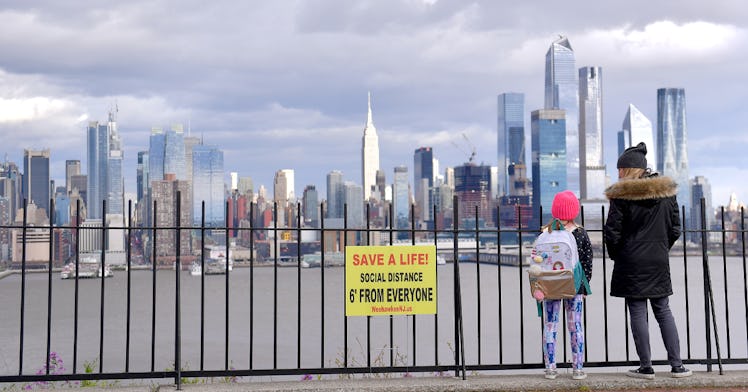What Trump’s 3 Reopening Social Distancing “Phases” Mean For Families
Here's what families need to know.

When will your kid go back to daycare? It’s not entirely clear, but if Trump’s new phases of social distancing rollback actually happen, there are some clues for families. Here’s what to know.
Yesterday evening, the Trump Administration released new guidelines for reopening the country on state and local levels. The guidelines, which define three phases for reopening the economy, requires that states and localities meet certain conditions before they can end some of the shutdowns that have closed restaurants and non-essential businesses across the country.
These conditions include a minimum two-week downturn in new cases and hospitalizations and adequate hospital bed, ICU, and testing capacities. The administration maintains that every state can meet this final requirement, but several governors have publicly stated that their states can’t test everyone they need to, and it sure looks like their opinion is the one that matters.
Trump, who initially said only he has the authority to open the economy, has seemed to at least temporarily defer to some of the states’ authority by providing guidelines for how and when states can decide to reopen while declining to make those decisions himself. So when push comes to shove, even governors that are on board with Trump’s guidelines likely won’t start to reopen businesses until they’re satisfied with their state’s testing capacity.
Further complicating the picture are the multi-state alliances that aim to align reopening plans among neighboring states. They’re efforts to prevent, for instance, the beaches of the Jersey Shore from opening and becoming dangerously crowded by New Yorkers whose beaches remain closed. So even if some states in one of these alliances meet the requirements to enter phase one, they may choose not to until all allied states do.
Trump could, of course, seek recourse against the states he sees as stalling unnecessarily, a move that would likely create even more uncertainty than already exists.
With those caveats, here are the three phases outlined by the Trump administration for reopening the economy. Each stipulates measured reopenings of specific businesses that can and should be reversed if conditions worsen.
Phase One
Phase one can commence if there’s a two-week downward trend in hospitalizations and confirmed cases, restaurants, movie theaters, sports venues, houses of worship, community centers, gyms, and other fitness businesses can reopen under social distancing guidelines. This likely means that many of these non-essential businesses will have to operate at a much lower capacity. Schools and bars in this phase will remain shut down, and there will still be no visits to senior facilities, as seniors are at the highest risk of dying from COVID-19 and nursing homes have been among the spaces hardest hit by the disease.
Phase Two
Phase two is the most important to working parents across the country. If everything in phase one goes well, schools can reopen again in phase two. Youth activities like camps and summer camps can also come back, nonessential travel (i.e. not just going to the grocery store) could return and parks and shopping centers could welcome visitors again.
Guidelines that would limit gatherings at 50 people or less would still remain in place. Non-essential businesses that were opened in Phase One — i.e. restaurants and other venues — can also ease some of their guidelines.
Even though schools would re-open, non-essential businesses that can conduct work remotely would still be encouraged to do so, although not required. Bars could also open at this phase under strict guidelines.
It should be noted that there are no timelines on any of these phases, giving individual states and localities lots of leeway into deciding when, if, and how they’ll reopen their economies. That could mean Phase One lasts three months until your state enacts Phase Two or that Phase Two might not happen for some time. It’s hard to say! No one really knows! Some cities — like Los Angeles – have preemptively banned large gatherings until 2021.
Phase Three
Phase three is the first phase where at-risk individuals can return to public life while still maintaining social distancing. Public venues could operate under less intense social distancing rules. Employers can bring on full workforces again.
Once again, it should be noted these phases are dependent on adequate testing, hospital beds, ICU units, and ventilators. If cases spike and hospitalizations increase, states are directed to return to previous phases or lock down their states again.